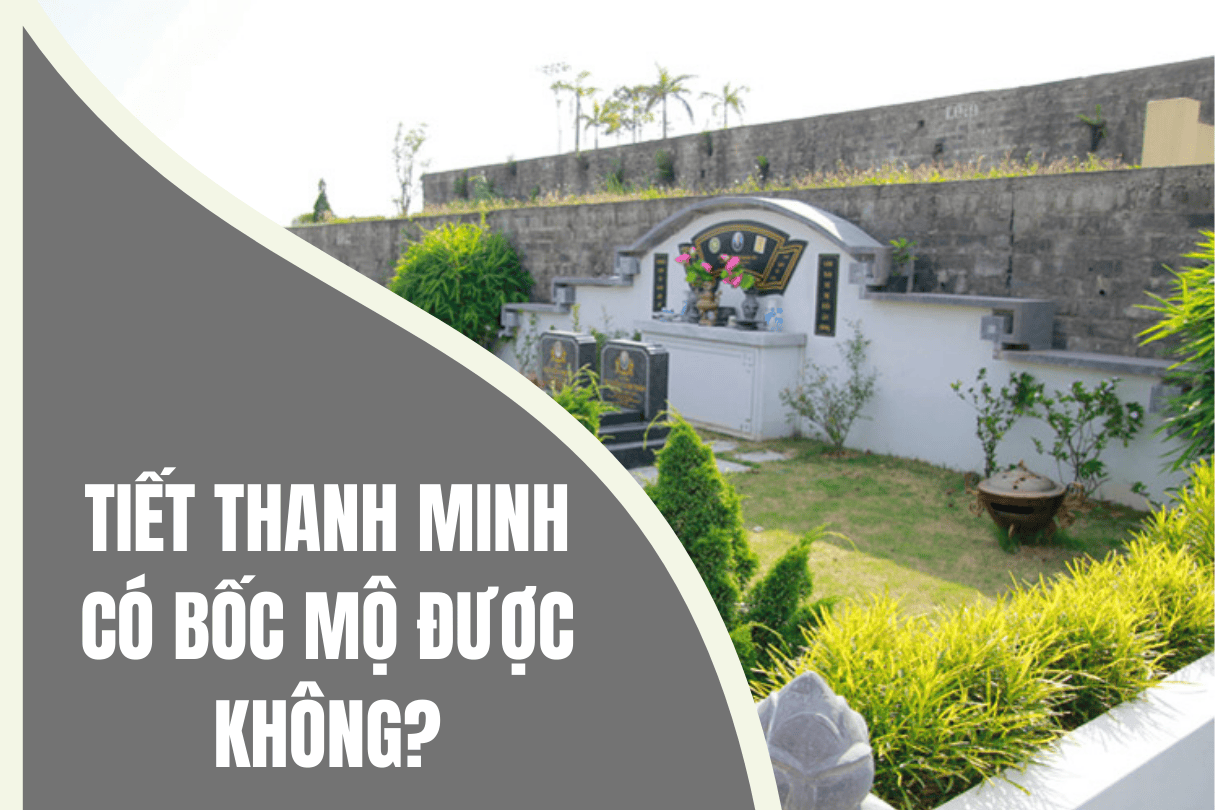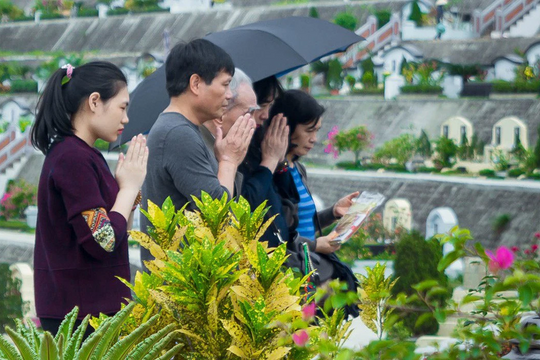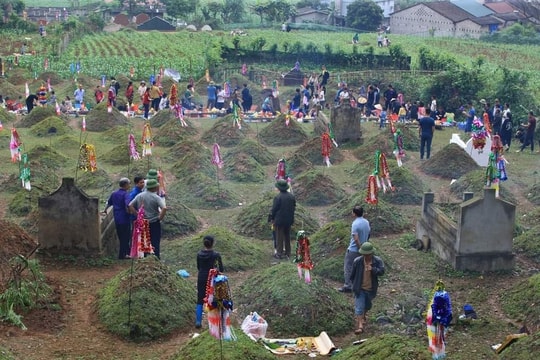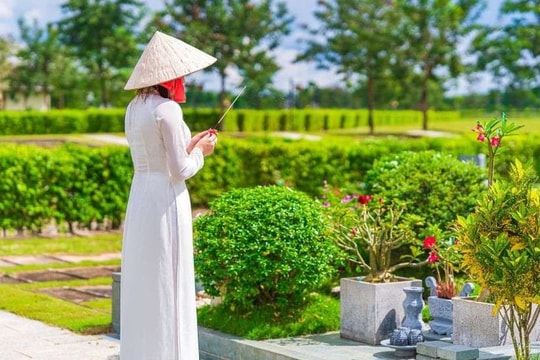Can graves be exhumed on Qingming Festival?
Can we exhume graves on Qingming Festival? What is the best day and time to exhume graves?
Can graves be exhumed on Qingming Festival?
Exhumation (reburial, reburial) is an important ritual in Vietnamese spiritual culture, expressing filial piety and respect to ancestors. Exhumation and reburial are usually performed after a period of burial, to move the remains of the deceased to a new resting place that is more spacious, cleaner and has good feng shui so that descendants can easily take care of the incense.

According to ancient customs, the deceased must wait at least 3 years (the mourning period) before their graves can be exhumed and buried. However, due to soil and environmental conditions, many families wait about 5-7 years to ensure the body has completely decomposed.
Leaving enough time for the remains to dry, avoiding the situation of "undecomposed grave" (the body has not fully decomposed) if the burial is done too soon.
The exhumation season usually falls in late autumn until before the winter solstice (ie around October-December of the lunar calendar every year). The reason is that the weather at this time is cool and dry, favorable for digging graves and limiting the spread of death odors and harmful bacteria.
According to folk experience, there are two main times to conduct grave exhumation: one is at the end of the year, after the Autumn Equinox; the other is at the beginning of the year,before Qingming Festival.
However, most families choose the end of the year, because performing spiritual activities at the beginning of the year can easily affect the family's luck and fortune in the new year.
Qingming Festival in early March (lunar calendar) is rarely chosen for grave excavation, except in special cases, because many people avoid moving graves at the beginning of the year.
What is the best day and time to exhume the grave?
Choosing a good day and month to exhume a grave is extremely important in traditional customs. According to folk beliefs, if a good day and time is chosen that is compatible with the deceased's age, the deceased's spirit will be at peace and will be blessed by their descendants; on the contrary, if a bad day is chosen, the passive spirit can bring bad luck to the family.
The family prepares to build a new grave before the exhumation. The selection of the location, direction of the grave and the construction of the new grave are done during the day to ensure everything is ready when the exhumation is carried out at night.
When choosing a date, the age (lunar year of birth) of the deceased and the age of the eldest son in the family will be considered to avoid conflicting years.
The eldest son is considered to shoulder the family's fate after the parents pass away, so his age is also considered so as not to conflict with the age of the deceased.
The ideal day to exhume the grave is a day that is compatible with the deceased's age, belongs to the Tam Hop, Luc Hop, Chi Duc Hop, Tu Kiem Hop groups, and has the five elements that are compatible or in harmony with the deceased's destiny.
On the contrary, you should avoid bad days such as Luc xung, Luc hinh, Luc hai days (days with strong conflicting earthly branches with your age), or days with bad directions (such as Kien, Pha, Nguy...) which can easily lead to bad luck and damage to vitality.
Choosing a good date and time carefully is to ensure the reburial ceremony goes smoothly, "at the right time and place" so that the soul can be invited to its new resting place with the most joy.
Things to avoid when moving sand and digging graves
Exhuming a grave is an important job in terms of the underworld, so our grandparents reminded their descendants to pay special attention to taboos so as not to violate spiritual taboos.
First of all, absolutely do not rebury if you encounter a "sealed grave" - that is, a grave that has good spiritual energy. Folklore believes that a closed grave is a grave that has absorbed the essence of heaven and earth, bringing blessings to descendants, so it must be kept intact for the family to prosper in the long term.
Besides the grave, there are also some other bad omens that need to be avoided. If the grave is located on bad land (offending or hitting the grave of another grave), you should also reconsider, to avoid "disturbing the dragon vein" affecting the whole area.
When it rains heavily and thunders on the day of the exhumation, people believe that it is a sign of bad weather, so many families will postpone the exhumation to another day to ensure safety.
Participants in the exhumation ceremony also need to be carefully selected: pregnant women, young children, people who have just recovered from illness or people with poor health should absolutely not be present at the exhumation site.
People whose zodiac signs conflict with the deceased's zodiac signs should be avoided from participating in the process of exhuming the grave, because according to feng shui, this conflict, if encountered at the grave, can bring bad luck to both.
Grave exhumation and reburial process
Before the reburial day, the homeowner prepares an ancestral worship ceremony at home to inform the ancestors about the upcoming grave relocation plan, and to ask the ancestors to bless everything to go smoothly.
On the night of the ceremony, a small altar is set up near the grave in the cemetery, with offerings including fruit, wine, votive paper, candles, etc.
The family respectfully worships Tho Cong (local deity), reads a prayer asking permission from the gods who manage the cemetery to allow their descendants to break ground on the grave.
This ritual is very important, to "knock on the door" to inform the spiritual world that the family has begun the exhumation process, hoping to gain the approval of the gods and the deceased.
After finishing the prayers, the exhumation team began digging the old grave. This work was done slowly and carefully, ensuring that they dug the grave of the deceased and avoided digging into the grave next door.
When the old coffin lid is revealed, people will usually light another incense stick to inform the spirit and wait a moment before opening the coffin lid.
When opening the coffin, if you observe any unusual signs (as mentioned above about a closed grave, or a body that has not fully decomposed), the homeowner must immediately stop and handle the situation.
If all goes well, the exhumation team will gently collect the remains one by one. They will spread a clean cloth beside the grave, then arrange the bones on it in their anatomical positions: the vertebrae are placed neatly in the shape of a person, the skull is placed high on top like a human head, the limbs are in order, ensuring nothing is missing.
Family members often use a flashlight to carefully check the grave, to avoid forgetting any bones. Our ancestors also used the method of lighting incense and observing the smoke. If the smoke gathered and spread straight out, it meant that there were no remains left in the grave.
Once all the remains have been collected, the next step is to clean the remains. The bones of the deceased are cleaned one by one by the monks or the exhumation team using scented water (usually water boiled with grapefruit leaves, aromatic leaves) or ginger wine. This work is done carefully and solemnly – each bone is washed with all the respect as if bathing the deceased.
After washing, the bones are gently dried and placed in the sarcophagus (a type of sarcophagus made of porcelain or alloy, depending on the family's preparation). People place the bones in order, top to bottom, inside and out: long bones are placed below, skull parts, teeth, and bone fragments are neatly placed inside, ensuring all parts are complete, symbolizing a complete body.
Once the arrangement is complete, the lid of the urn is sealed and cemented or glued tightly to prevent the air from escaping. At this point, a new home – a small, pretty coffin – has completely embraced the remains of the deceased, ready to be moved to a new resting place.
Finally, the ceramic urn containing the remains is lowered into the new grave. The family performs the earth-filling rituals (filling the soil, rebuilding the tomb lid) and burns incense to announce completion.
Some places also perform a “grave-protecting” ceremony by placing a few talismans or ancient coins in the grave before filling it to calm the dragon vein. When the new grave is completed, the next morning the family prepares offerings to thank the gods and invite the spirit to settle in the new grave.
From here, the spirit of the deceased officially “rests in a new grave” forever. After completing the grave-exhumation ceremony, descendants feel relieved because they have fulfilled their filial duties, believing that their loved ones have a better resting place and will continue to bless the family with peace and prosperity.
Exhuming graves on Qingming Festival or at the end of the year is a big event imbued with spirituality and traditional customs. Performing it at the right time, following all taboos and performing the right rituals will not only help the deceased's soul to be liberated and rest in peace, but also bring peace and happiness to their descendants.
Each beautiful green grass grave, each dry bone neatly placed in the sand is a testament to filial piety and the virtue of “remembering the source of water” that has been passed down for generations in Vietnamese culture. With careful and sincere preparation, the exhumation and reburial ceremony will go smoothly, helping the deceased to “rest in peace” and their descendants to be at peace, continuing to enjoy the blessings of their ancestors.




